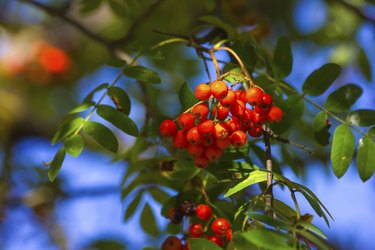
Mountain ashes (Sorbus spp.) have full, deep green leaf canopies in summer. In spring, the trees are covered in dense clusters of white flowers, and provide colorful orange ornamental berries in fall. The Korean mountain ash (Sorbus alnifolia), which grows in U.S. Department of Agriculture plant hardiness zones 4 through 7, and the European mountain ash (Sorbus aucuparia), which grows in USDA zones 3 through 6, are the two varieties you're likely to find at the garden center.
Site Specifics
Video of the Day
Mountain ash trees grow best in full, all-day sun. They tolerate most acidic soil types, including clay, loam and sandy soils, although the Korean mountain ash can survive in slightly alkaline soil. Mountain ashes can tolerate mild droughts, but the healthiest growth occurs in well-drained, moist sites. Both European and Korean mountain ashes can grow up to 25 feet wide, so avoid growing them within 15 feet of of buildings or large shrubs or trees. A mountain ash sheds its dense canopy of leaves and fruits annually, which can pose a litter problem near sidewalks and streets.
Video of the Day
General Care
Trees grown near lawns watered by a sprinkler system rarely need additional watering. Deep watering, enough to moisten the root zone, is only necessary during an extended dry period in summer. Fertilize your mountain ash in early spring when growth resumes. Apply a 20-20-20 blend fertilizer, dissolving 2 teaspoons per 1 gallon of water and applying 1 quart of the solution per every square 1 foot of soil beneath the mountain ash canopy.
Pruning Tips
Late winter pruning keeps a mountain ash tree healthy and attractive. Dip the pruning tools in a solution of 1 part bleach to 9 parts water solution after every cut to disinfect them. Cut back any dead wood to the nearest healthy wood, or make the cuts flush to the main trunk or the nearest healthy branch. You can determine where the healthy wood begins by lightly nicking the branch with a disinfected knife until you reveal living, green wood. Remove any crossed or weak branches, while maintaining the symmetry of the tree. Annual pruning can prevent mountain ash decline problems and also minimizes the chances of branch breakage.
Insects and Diseases
Mountain ashes are prone to several diseases. Fungal problems, like leaf spot diseases, can cause discoloration on the leaves but you don't normally need to treat these diseases. Raking up dead leaves in the fall may help prevent fungal spores from overwintering and reinfecting the tree in spring. Fire blight and Cytospora canker cause sunken, sometimes slimy, cankers to form on the trunk and branches, with blight symptoms also including flower loss. Cut out cankerous wood back 4 inches from the canker with disinfected shears, and remove any suckers that grow around the base of the tree. Borers, aphids, sawflies and scale insects may weaken a mountain ash. Korean mountain ash is resistant to borers. You can control scales and soft-bodied insects, like aphids, by drenching the tree with a ready-to-use summer horticultural oil spray when the insects are active. Always wear long sleeves, long pants and eye protection when working with garden chemicals. Yellow and black sawfly larvae feed on the foliage, but rarely kill the trees. You can prune out badly infested branches or apply a horticultural oil to kill the larvae.
- University of Vermont Extension: Mountain Ash Trees
- University of Florida IFAS Extension: Sorbus Aucuparia: European Mountain-Ash
- University of Florida IFAS Extension: Sorbus Alnifolia: Korean Mountain-Ash
- Brandon University Extension: Mountan Ash Decline
- Penn State University Extension: Mountain Ash Diseases
- University of Minnesota Extension: Mountainash Sawfly